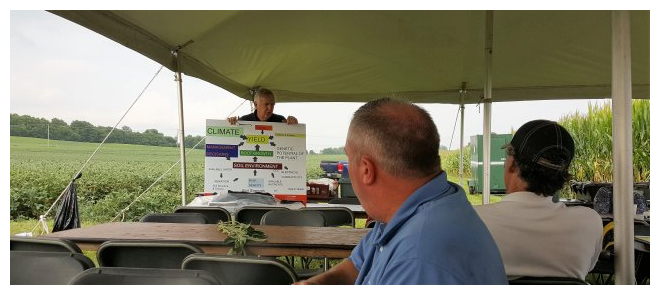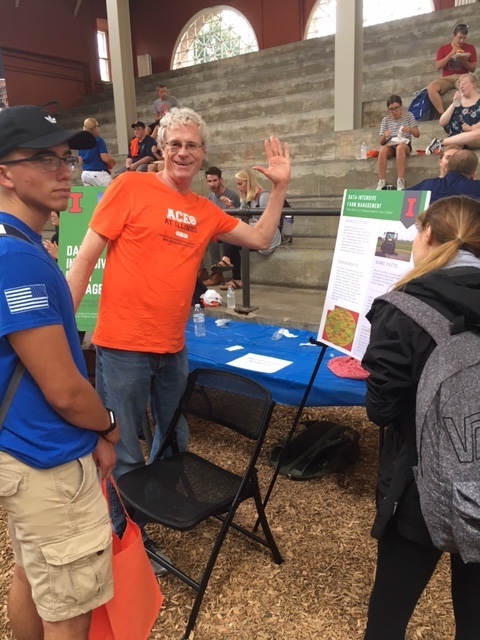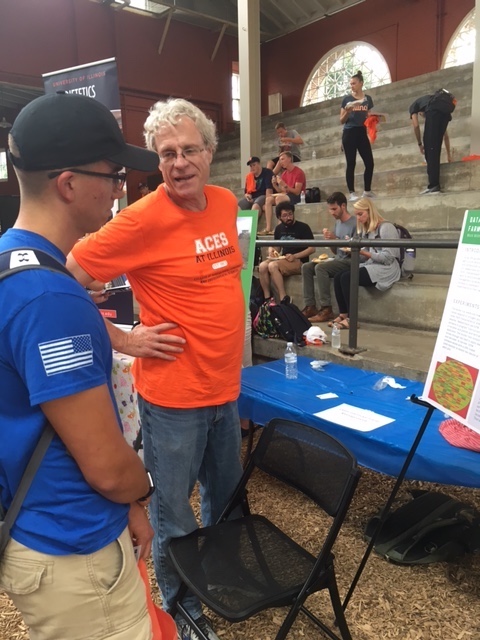University of Illinois graduate student Aolin Gong attended the Illinois Economics Association 48th Annual Meeting. She presented her second year paper, “An Investigation into the Optimal Plot Length in On-farm Trials.”
Tag Archives: data-intensive farm management
Paula Girón named International Plant Nutrition Institute’s (IPNI) 31 Scholar Award recipient
DIFM graduate researcher Paula Girón was named one of the International Plant Nutrition Institute’s (IPNI) 31 Scholar Award recipients. The IPNI awards graduate students in countries with an IPNI program in science programs relevant to plant nutrition science and the management of crop nutrients.
Paula Girón is working toward her M.Sc. in soil since at the University of Buenos Aires in Argentina. She is working on a thesis focusing on site-specific nitrogen management in maize in the northwestern Buenos Aires province. Girón was a visiting scholar with the DIFM project during fall semester of 2016.
First Look at New DIFM Publication
Professors David Bullock, Maria Boerngen, and Divina Gracia P. Rodriguez just received a first look at their accepted paper in the Agronomy Journal, titled “The Origins, Implications, and Consequences of Yield-Based Nitrogen Fertilizer Management.” Take a look!
Developing an Affordable, Retrofittable Yield Monitor for Cotton
During a trip to Colombia by Brendan Kuhns, it became clear that yield monitors for cotton are hard to come by, especially the kind that is retrofittable on older machines. Fortunately, DIFM researcher Dr. Tony Grift did his PhD on the development of a generic method for mass flow sensing of granular materials (fertilizers in particular), and he is eager to apply his method to cotton. We will build a new optical photo-interruption arrangement that measures the spacing durations between clumps of cotton passing a sensor. Then we will apply the theory of arrival processes to determine the number of cotton clumps that pass the sensor per unit of time, which is an indirect measure of the mass flow.
What is so fascinating about this method is that it works by only measuring the spacing times in between cotton clumps. So without knowing or measuring any material parameters, we still can measure the mass flow. It gets better: the measurement device does not need calibration, since nature is literally doing the work. If you would like to read details, here are links to paper 1 and paper 2 (the second won an award from the EurAgEng organization).
We hope that this small project will also connect our statisticians with the engineers (no easy feat!). For more information, feel free to read Dr. Grift’s essay titled “Embracing variability: How to hug a cactus”, which he claims to be “loosely based on the brother of our fearless leader David Bullock.”

Figure 1 Shown is the mass flow sensing scenario; we have clumps of material (cotton balls) and we measure the spacing durations among them. Believe it or not, using Poisson driven arrival theory, these data are sufficient to determine how many clumps are passing the sensor per unit of time, irrespective or the overlapping effect. Isn’t statistics great?
Abstract Submitted to the Research Showcase at the Illinois Nutrient Loss Reduction Strategy Second Annual Workshop
Professor Bullock, in conjunction with members of the team behind the recent NSF INFEWS application, submitted the following abstract for consideration in the upcoming INLRS Annual Workshop’s Research Showcase:
We propose to create an integrated FEW model and with user-friendly software to 1) enable individual farmers to examine the predicted economic and environmental impacts of their fertilizer management strategies, and 2) provide policy makers with a user-friendly tool in order to design policies that will lead to efficient reduction of N-nitrate contamination in the Mississippi River Basin. The model will be based on the ideal CyberGIS computation platform, and expand to the scale of the Mississippi River Basin the DSSAT crop growth model and the SWAT water drainage model. The model will also integrate the BioScope model of biomass supply, and a partial equilibrium economic model of crop, energy, and biomass markets in the U.S. Midwest and beyond. We argue that the principal shortcoming of current agricultural “Big Data” is that there is little record of variance in managed input use. Of course, managing inputs efficiently is the whole point of farm management, whether the goal is to increase monetary returns or environmental sustainability. Therefore, we propose to parameterize our integrated model with data we generate from large-scale, on-farm agronomic field trials over an entire small watershed. Those trials will randomize N application rates and cover-crop management strategies to measure both yield and water quality results of varying these managed input variables. We will use the generated data with existing agricultural “Big Data” to create “decision tool” software to improve private and public crop fertilization strategies. The proposed research will rely heavily on the proven abilities and infrastructure of the CyberGIS Center for Advanced Digital and Spatial Studies, and on the software, administrative capacity, and scientist-farmer relationships developed in an on-going USDA-NIFA Food Security project on data-intensive fertilizer management. In addition, we will provide opportunities for underrepresented undergraduates to gain research experience through an extension of the WE CAN program.
New Faces at DIFM
Joshua Babes is an undergraduate at UIUC studying Agricultural and Consumer Economics who is volunteering to work with the Data-Intensive Farm Management project. Joshua comes from the north side of Chicago and is working towards a career in consulting doing data analytics. He hopes to begin to learn more about the analytics while contributing to DIFM.
DIFM at the Highland Community College Field Day
Robert Dunker attended the Highland Community College Field Day on August 29, 2018 in Freeport Illinois. The DIFM Program had a booth to distribute information about farmer recruitment and participation. Several students and farmers stopped by the booth to learn more about the program and how they could become involved.
DIFM at the Kane County Corn Growers Plot Meeting
On August 21, Dennis Bowman, University of Illinois Extension Educator, spoke to 45 farmers and agricultural professionals at the Kane County Corn Growers Plot Meeting. He explained the goals and methods of the DIFM project.

DIFM at the ACES Fall Festival
DIFM participated in the ACES Fall Festival, which invites undergraduate students in the College of Agricultural and Environmental Sciences to come to the U of I Stock Pavilion in order to learn about available opportunities at the College. Groups from the U of I Rodeo Club to the DIFM project had booths at the Fall Festival.

At the Festival, we sought to attract students looking for undergraduate research experiences, and to recruit farm families to join in the project. At present, two students David Bullock met at the Fall Festival are interested in participating in our research, and one farm family has expressed interest in running a trial on their fields.

Applications for Future Funding
In the fall of 2018, the DIFM project is working with collaborators around the globe to ensure continued funding for our work. At present, we have turned in applications to CGIAR and to the Interdisciplinary Collaborations in Extension Grant. We’re hoping to hear back on these applications in the coming months!

